In late April I returned for a week to Midway Atoll for my fifth visit in four years and my sixth in total. Regular readers of this blog will be familiar with my unbridled enthusiasm for Midway, one of the world’s truly great wildlife destinations. It is a special, special place and one which I will try to return to on an annual basis assuming visitor services remain intact. This year I travelled with a smaller group than normal and apart from meal times, I was pretty much on my own the whole time. Perfect. Just me, the birds and the beautiful atoll environment.
Midway is home to approximately three quarters of the world’s breeding population of Laysan Albatrosses. Including chicks, they number almost one million. Midway also hosts approximately 60,000 Black-Footed Albatrosses, comprising 35% of the global population of the species and the largest colony of its kind on this planet. On my previous visits, I have largely concentrated on the Laysans simply because they are more numerous but this year I spent much of my time in an area populated by large numbers of Black-Footed Albatrosses with the aim of increasing my image portfolio of this species.
Everything about Albatrosses can be described as superlative and immense: from their longevity (up to 60 years) to their flight endurance (a minimum of three million miles in an average life, equivalent to flying around the earth at the equator three times per year), to their enormous wing spans. The Laysans and Black-Footed Albatrosses are among the smaller of the Albatross species yet still have wing spans of seven to eight feet.
One of the advantages of spending long periods in the company of wild animals is that after a while, you start to get familiar with their behavior patterns. When the Black-Footed Albatrosses land, they will typically spend a few minutes grooming themselves after which they will undertake a big wing stretch, followed by a shake of the wings. To take this first image, I was able to crawl on my belly up to this Albatross after it landed. With the bird only a few feet away from me, I kept the camera viewfinder glued to my eye (in fact I was using an angle-finder attached to the viewfinder so that I could get the lowest possible perspective). As soon as the wing stretch occurred I was ready with the shutter.
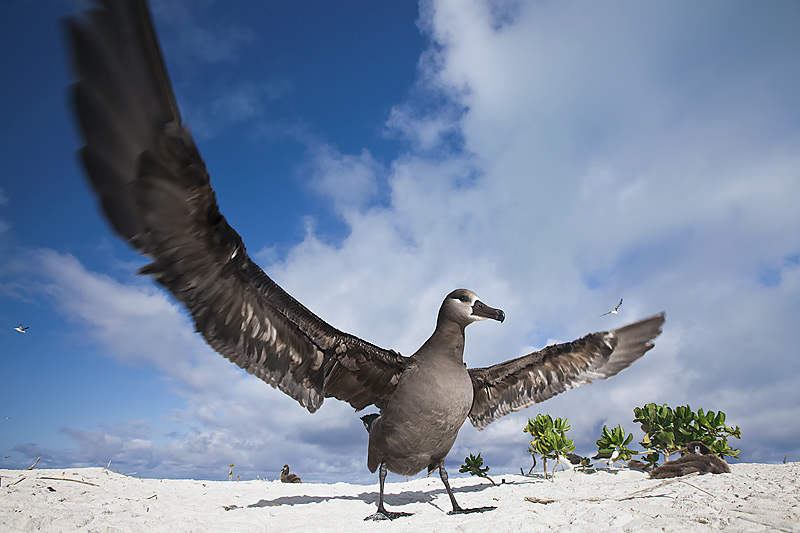
Black-Footed Albatross stretching wings, Midway Atoll, USA. Canon 5D MK2, Canon 16-35mm f2.8 lens @16mm, Hoya polariser filter, angle-finder, camera resting on sand, AV (at zero), 1/400th sec, f9, ISO 400
Slightly larger and shyer than the Laysans, they also have a different, more frantic courtship dance – one which involves plenty of rapid-fire head shakes as opposed to the more measured head bobbing favoured by the Laysans. For these next two images, I again used a wide-angle lens at or close to the widest focal length, and an angle finder. The birds appeared completely oblivious to my presence, at one point even stepping on my arm as I lay in the sand and I found that I was constantly having to shove myself backwards in the sand in order to distance myself from the birds so that I could include both in the frame.
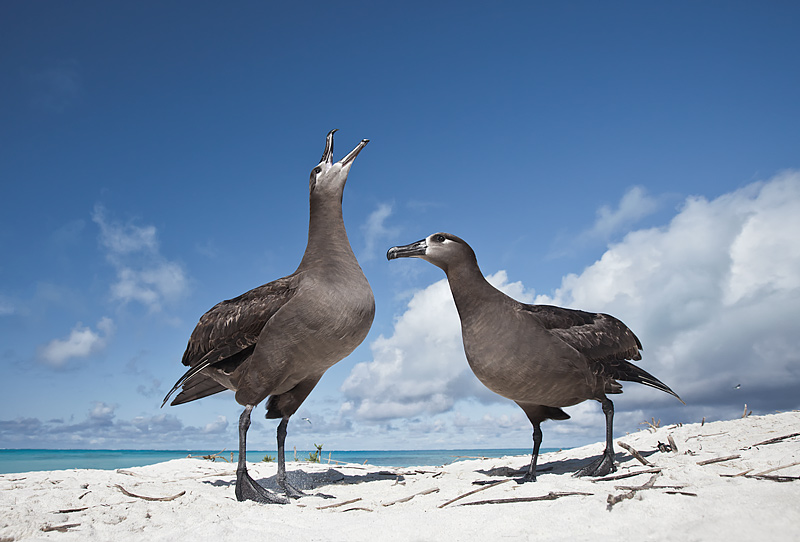
Black-Footed Albatross pair engaged in courtship dance on a beach overlooking lagoon, Midway Atoll, USA. Canon 5D MK2, Canon 16-35 f2.8 lens @17mm, Hoya circular polariser filter, angle finder, camera resting on sand, AV (at zero), 1/640th sec, f8, ISO 400
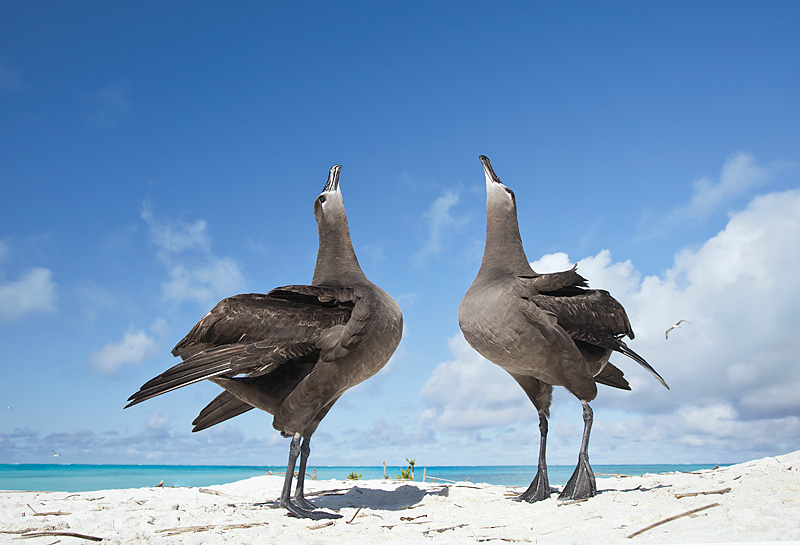
Black-Footed Albatross pair engaged in courtship dance on a beach overlooking lagoon at Midway Atoll, USA. Canon 5D MK2, Canon 16-35mm f2.8 lens @17mm, Hoya circular polariser, angle finder, camera resting on sand, AV, 1/640th sec, f8, ISO 500
This next image of courting Black-Footed Albatrosses was taken at sunset using a 300mm telephoto lens, with the white balance on the camera manually set at 8,000 kelvin to accentuate the sunset colours and with a fair amount of under exposure dialed in to render the birds as silhouettes.
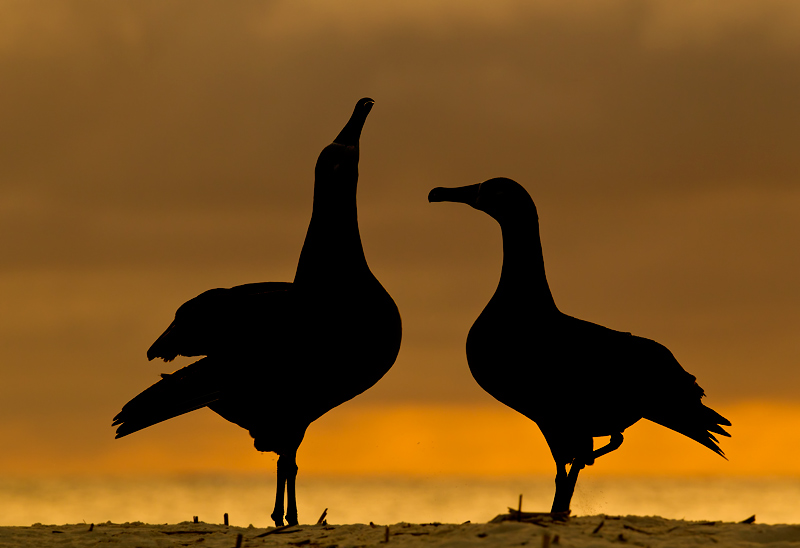
Black-Footed Albatross pair engaged in courtship dance, silhouetted at sunset, Midway Atoll, USA. Canon 1DMK4, Canon 300mm f2.8 lens handheld, AV (-1), 1/640 sec, f8, ISO 400, manual white balance at 8,000k.
Aside from the courtship dancing, I wanted to capture the interaction between both the adult pairs and the adults and their chicks. In order to get down to eye-level with the birds, I shot all of the following images lying on the ground, on my side, handholding the camera and lens, which comprised a 300mm f2.8 lens usually with a 1.4x converter. I found lying on my side and using the shutter release on the vertical side of the camera afforded me the most comfort when lying in this position for long periods of time. The birds were rarely if ever still which made focusing difficult but if I could get parallel to the birds, using all 45 focusing points on the Mark IV, focusing worked quite well. I positioned myself so that the background was a dark distant Ironwood tree forest. The telephoto lens helped to render this to a fairly uniform dark or medium green. I knew I needed a relatively small aperture to increase depth of field in order to keep both birds (or most of them) in focus but with the dark background and often overcast conditions, I was regularly fighting for sufficient shutter speed and needed to regularly crank up the ISO to levels of 1600+.
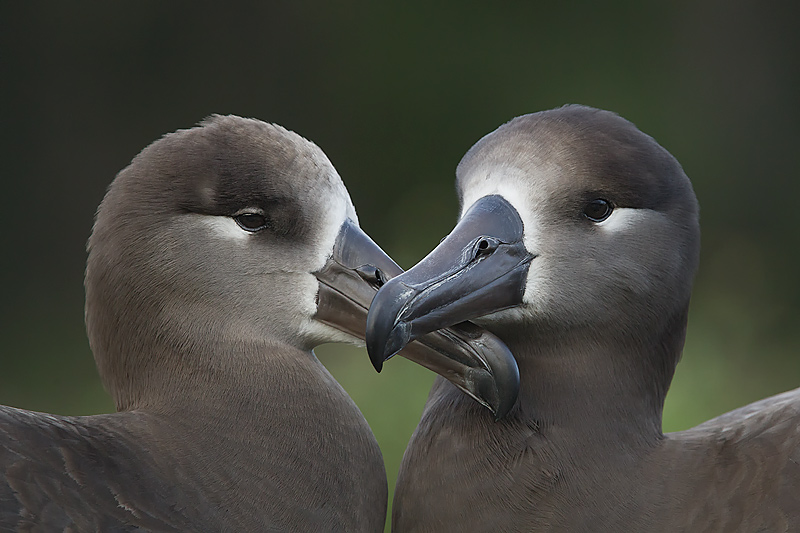
Black-Footed Albatross couple nuzzling, Midway Atoll, USA. Canon 1DMK4, Canon 300mm f2.8 lens +1.4x TC, handheld, AV (-1), 1/320 sec, f8, ISO 2,000.
The adult birds often travel hundreds of miles out to sea on long distance foraging trips and once the chicks are more than 4-6 weeks old, the adults can be away for periods of up to three weeks. Not surprisingly, when they return to their nesting sites on Midway, they are greeted by a ravenous chick.
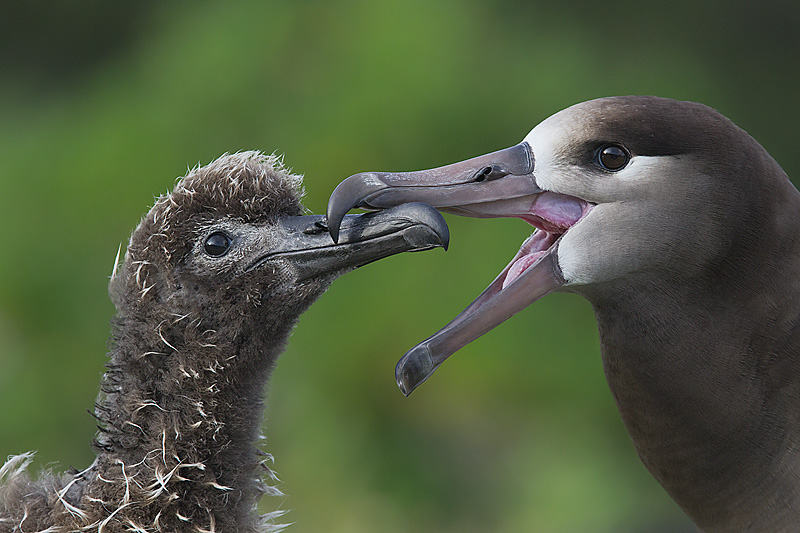
Black-Footed Albatross chick begging for food, Midway Atoll, USA. Canon 1DMK4, Canon 300mm f2.8 lens +1.4x TC, handheld, AV (-2/3), 1/640 sec, f8, ISO 2,000
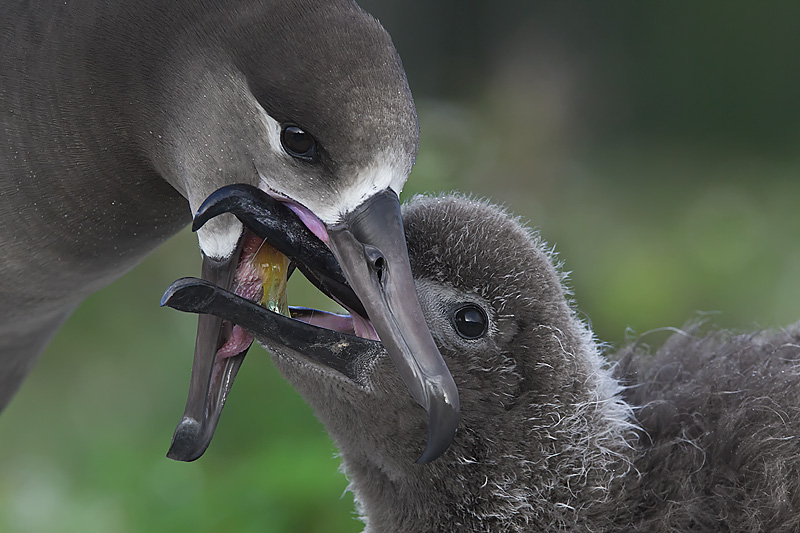
Adult Black-Footed Albatross feeding chick regurgitated squid/fish/fish eggs, Midway Atoll, USA. Canon 1DMK4, Canon 300mm f2.8 lens +1.4x TC, handheld, AV (-2/3), 1/500 sec, f8, ISO 2,000
If there’s one single piece of advice I would give to budding photographers it is this: if you have the chance and especially if your background is dark, always, always shoot back lit.
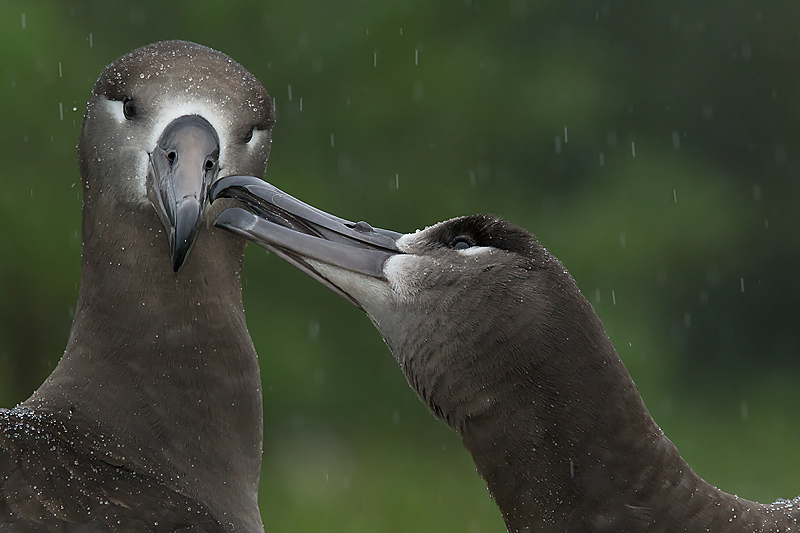
Black-Footed Albatross pair grooming in the rain, Midway Atoll, USA. Canon 1DMK4, Canon 300mm f2.8 lens + 1.4x TC, handheld, AV (-1 2/3rds), 1/640 sec, f9, ISO 2,000, fill flash with Canon 580 EX 2 speedlight at -2.
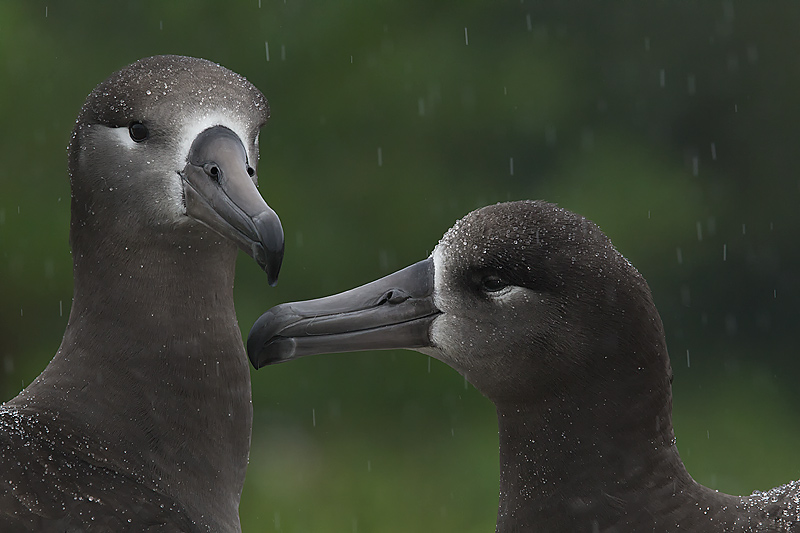
Black-Footed Albatross pair in the rain, Midway Atoll, USA. Canon 1DMK4, Canon 300mm f2.8 lens +1.4x TC, handheld, AV (-1 2/3), 1/640 sec, f9, ISO 2000, Canon 580 EX 2 speedlight fill flash at -2.
The downy feathered chicks take on comical appearances when wet, almost as if they had gone a little heavy on the hair-gel…
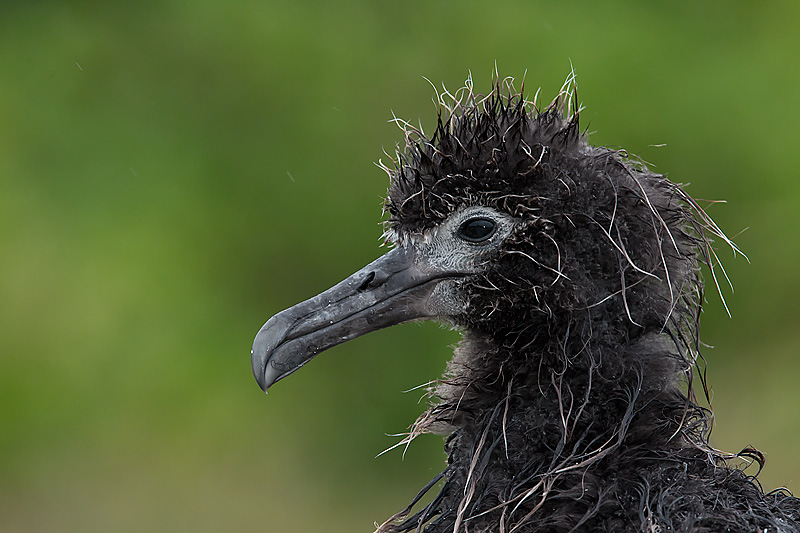
Rain-sodden Balck-Footed Albatross chick, Midway Atoll, USA. Canon 1DMK4, Canon 300mm f2.8 lens +1.4x TC, handheld, AV (-1), 1/320, f9, ISO 2000, Canon 580 EX2 at -2.
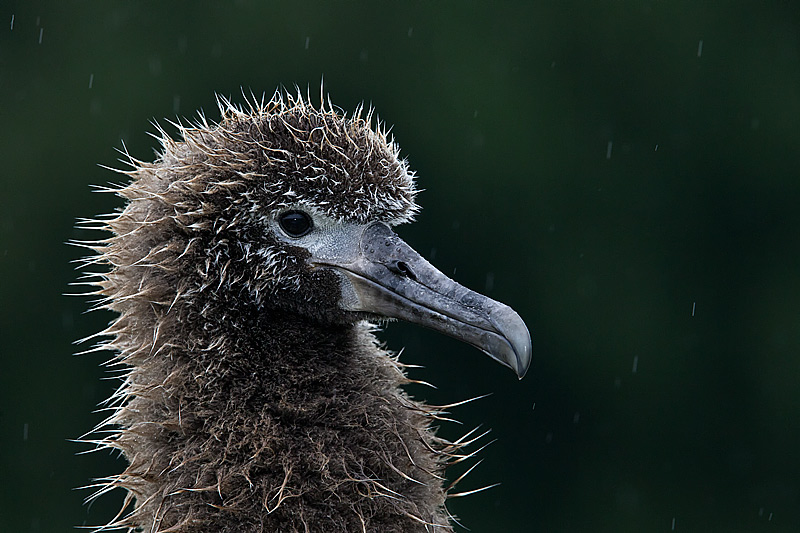
Rain sodden Laysan Albatross chick, with spiky wet feathers, Midway Atoll, USA. Canon 1D MK4, Canon 300mm f2.8 lens + 1.4x TC, handheld, AV (-1 1/3), 1/400th sec, f9, ISO 1,600, Canon 580 EX2 speedlight at -2.
I didn’t ignore the Laysans and took these candid images of the adults interacting among themselves and with their chicks.
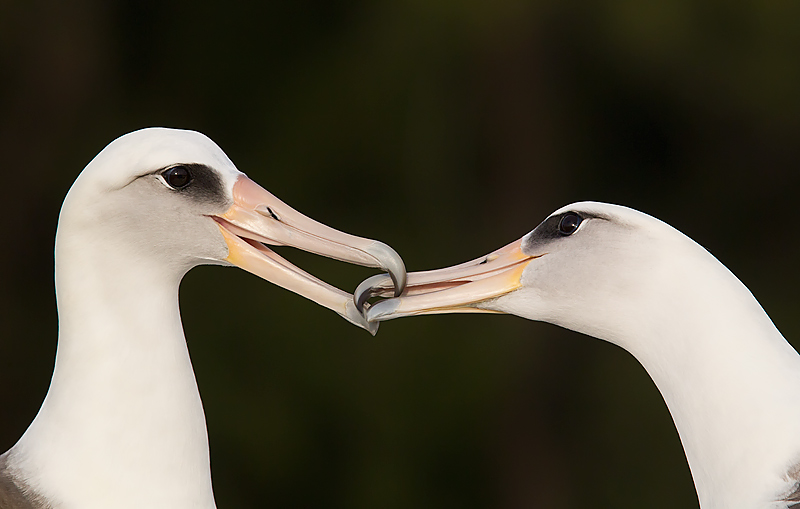
Courting Laysan Albatross pair. "sword fighting" with bills, Midway Atoll, USA. Canon 1D MK4, Canon 300mm f2.8 lens +1.4x TC, handheld, AV (-1), 1/2000 sec, f9, ISO 1600
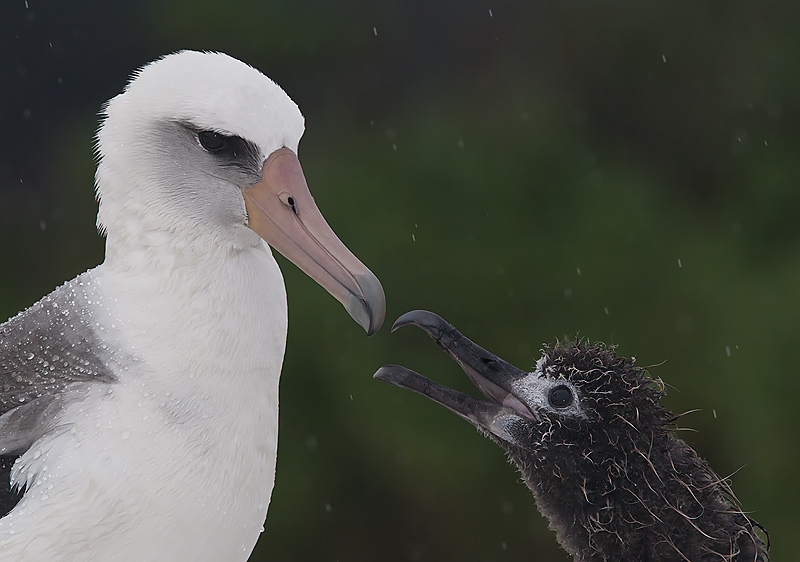
Laysan Albatross chick begging for food from its parent, Midway Atoll, USA. Canon 1DMK4, Canon 300mm f2.8 lens +1.4x TC, handheld, AV (-1), 1/2000, f9, ISO 1600, Canon 580 EX2 speedlight at -2.
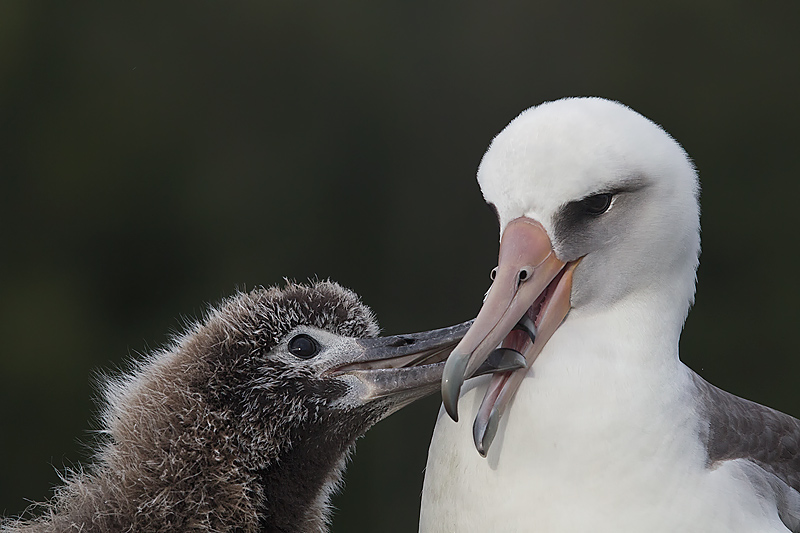
Laysan Albatross chick begging for food from its parent, Midway Atoll, USA. Canon 1DMK4, 300mm f2.8 lens, handheld, AV (-2/3), 1/1000 sec, f9, ISO 1600
One of the things you learn as your photography improves is the importance of backgrounds in your images. Quite often, I’ll become attracted to a background before any subject materialises. Often you need a lot of patience in these sorts of situations. Underwater, I’ve sometimes spent nearly a whole dive positioned in front of a colourful Sea Fan waiting for the right fish to swim by in front of it.
Half way down the international sized runway on Midway’s main island, there are several large Sea Grape trees which always seem to have a mass of brown and red leaves and which contrast nicely with the green coloured Ironwood trees on either side as well as the brilliant yellow flowers of the Verbasinia plants nearer to the ground. I had noticed that the Albatrosses would regularly fly past the trees and I thought that if I used a slow shutter speed and panned with the birds, sometimes using a little fill flash, that I might get some interesting images. Blurs are very much a matter of personal taste with my own preference being for the eyes and head of the subject to be relatively sharp but in the case of flying birds, for the wings to be blurred. This means that you do not want to use a very slow shutter speed. Depending on the speed of the flying bird, anything from 1/20th to 1/60th of a second usually works best.
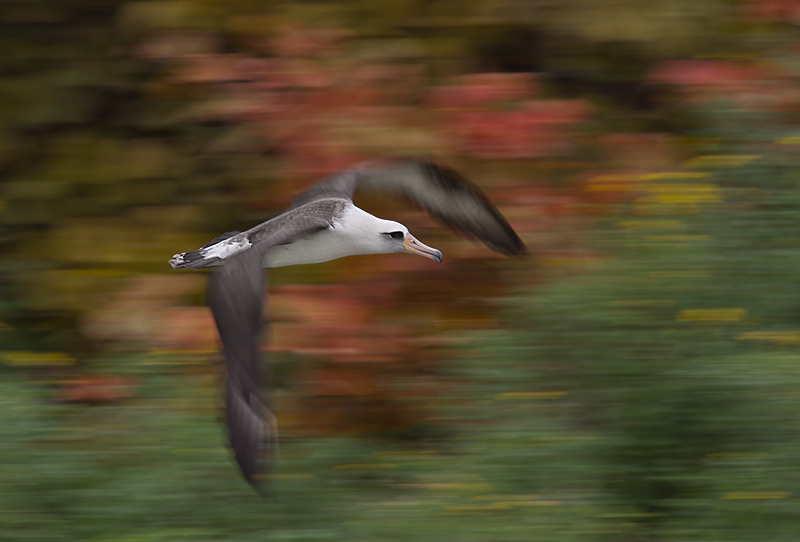
Laysan Albatross flying past Sea Grape tree, with motion, Midway Atoll, USA. Canon 1D MK4, Canon 300mm f2.8 lens +1.4x TC, handheld, manual exposure, 1/60 sec, f11, ISO 50
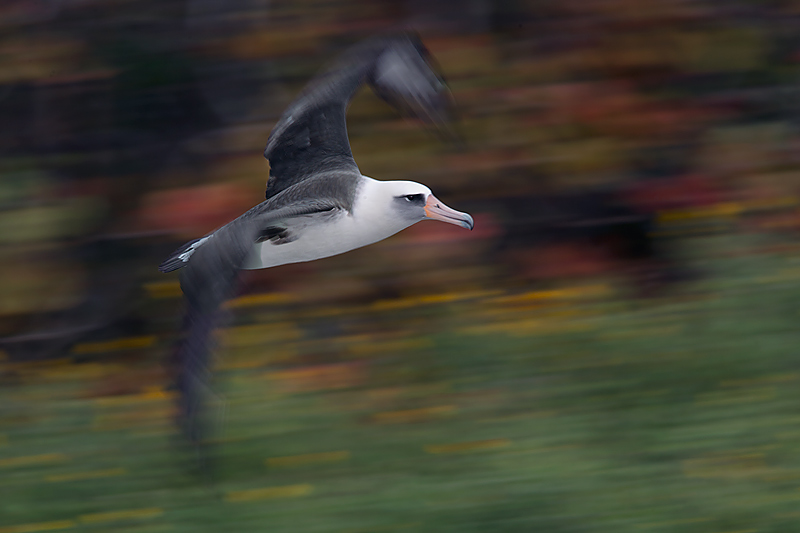
Laysan Albatross flying past Sea Grape tree and Verbasinia plants, Midway Atoll, USA. Canon 1D MK4, Canon 300mm f2.8 lens +1.4x TC, handheld, manual exposure, 1/60 sec, f13, ISO 50, Canon 580 EX2 at -2 2/3, Better Beamer.
I had purposely chosen to go as late as possible during the visitor season in the hope that some of the White Tern chicks would have hatched. While I was able to locate several adults sitting on eggs, I was unable to find any chicks apart from two on my one day visit to nearby Eastern Island. Unfortunately neither of these was in a particularly photographic position. I still spent plenty of time with the adults as they really are my favourite bird – so pretty and elegant. If you are in any doubt, look at this beautiful specimen.
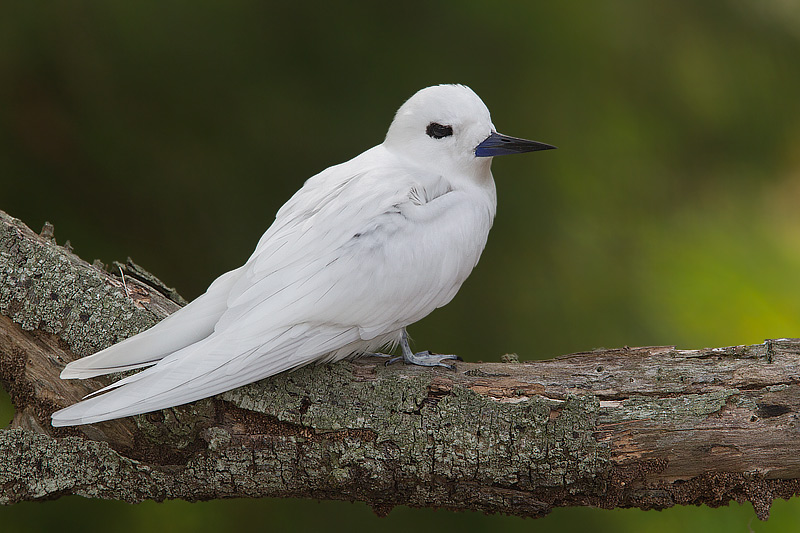
Adult White Tern on Ironwood tree branch, Midway Atoll, USA. Canon 1D MK4, Canon 300mm f2.8 lens with 1.4x TC, handheld, AV (-1/3), 1/400sec, f9, ISO 640, Canon 580 EX2 speedlight at -2 1/3.
I also witnessed a piece of behaviour that I had not seen before. On many occasions I have seen adult White Terns feed their chicks fish. So when I found an adult with a fish in its bill perched on a low tree branch, I felt certain that there must be a chick nearby. I looked and looked but found nothing. The adult remained in the same position for nearly an hour during which time it kept lifting its head and scanning the branches above it. I began to wonder if there had been a chick higher up which had either fallen from its perch – something that is not uncommon given that White Terns do not build nests, leaving the chicks vulnerable during high winds. But with no signs of any chick on the ground, I speculated that perhaps the chick had been taken by an avian predator such as a Great Frigate bird. Suddenly there was a swish of white in the upper branches and I looked up to see another adult Tern alight above the lower one. The latter immediately took flight, landing beside its companion to which it promptly offered the fish to and which was greedily accepted. When I asked the resident biologists about this, I was told that this was part of White Tern courtship behaviour.
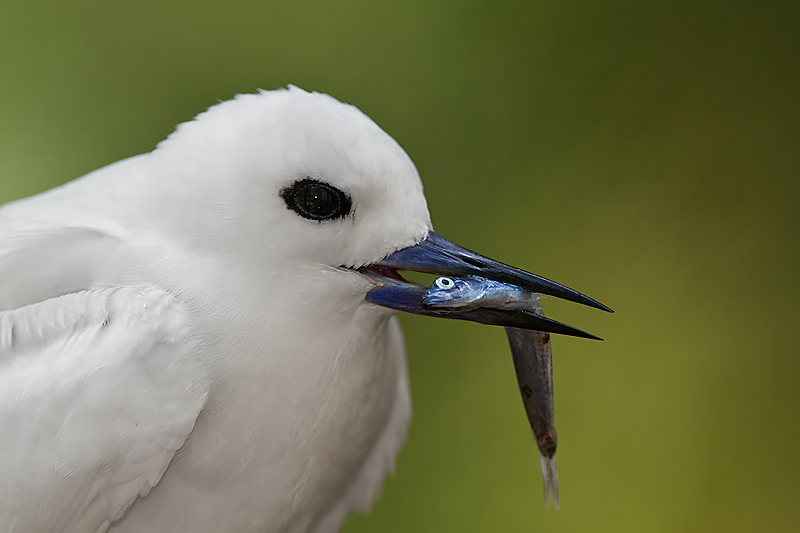
Adult White Tern holding fish in its bill, Midway Atoll, USA. Canon 1D MK4, Canon 300mm f2.8 lens +1.4x TC + 37mm of extension tube, handheld, AV (-1/3), 1/320 sec, f6.3, ISO 640, Canon 580 EX2 speedlight at -2 1/3.
Midway is home to two other Tern species – Sooty and Gray-Backed Terns. It is also home to two Noddy species – Brown and Black Noddies. There are 6,000 nesting pairs of Black Noddies on Midway and in certain areas they can be seen high up in the Ironwood trees, sitting on their nests. Sometimes though they can also be seen out in the open; in this case perched on a sea wall overlooking Midway’s lagoon. This particular bird tolerated a remarkably close approach – to the minimum distance of my 300mm lens. I sat with it over a long period of time, during which it largely dozed in the breezed. But every now and then, another bird would fly sufficiently close to elicit a warning call. I had no idea the Noddy’s tongue was quite so long and vividly colored!
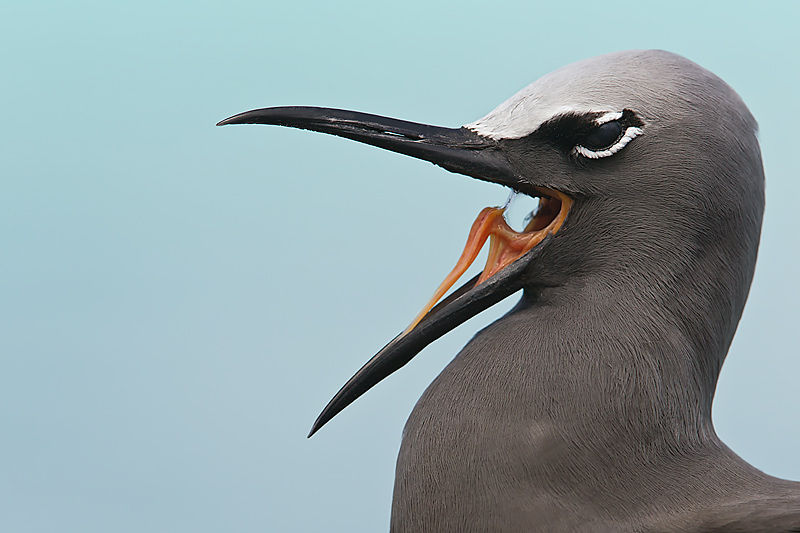
Black Noddy calling, Midway Atoll, USA. Canon 1D MK4, Canon 300mm f2.8 lens +1.4x TC, handheld, manual exposure, 1,000 sec, f8, ISO 400
After last year’s experimentation with remote wireless triggers and running Albatrosses, I came prepared to try again this year. For those of you who missed lat year’s blog, the idea is to take close-focus, fish-eye images of running Albatrosses by burying ziploc bag-encased cameras with fisheye lenses and with manual wireless triggers attached to the cameras, in the sand, along the natural sand “runways” that the Albatrosses run along at high speed in order to take flight. The camera shutters are triggered wirelessly by yours truely as I wait hidden behind the bushes or dunes that line the runway. All camera settings are fixed in advance (once in the bags in the sand, these are hard to change). I used an AV setting, dialling in some compensation depending on the sun/cloud conditions and focusing was switched to manual. Many times I would be set up eg for sunny conditions and a cloud would cover the sun just as the birds ran over or past the camera resulting in underexposure. Then I would set up for cloudy conditions, dialling in +ve exposure, and the sun would come out. I used two camera bodies, a Canon 5D MK 2 and a Canon 1D MK 4 with a 15mm fish-eye lens on the 5D and an 8-15mm zoom lens on the MK4. Given that the images were typically taken at distances of 4ft or less, anything more than 15mm on the 5D and about 11mm on the Mk4 (which has a 1.3x cropped sensor) is not wide enough. Strangely, I found that 8-15mm lens even when set at the equivalent focal length on the MK4 as the 15mm on the 5D, required 2/3rds to a full stop more of light. Despite all these technical issues, the greatest challenge was hoping the birds would run directly at and over the camera (or should I say, lens, since that is all that was poking out of the sand); and secondly, trying to press the manual triggers at the exact moment when the birds were just in front or over the lens – a very challenging proposition given the speed with which they run at.
The vast majority of images had only bits of Albatross in the frame or were poorly exposed, but very occassionaly I got lucky. I think I have improved from last year but am still striving for that “killer” image. Here is a very small sampling from this year.
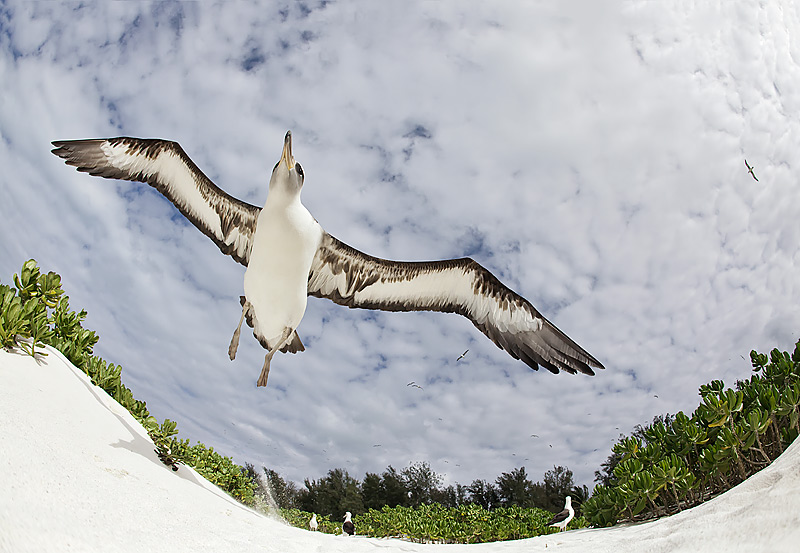
Laysan Albatross taking flight, close-focus, fish-eye, Midway Atoll, USA. Canon 5D MK2, Canon 15mm fish-eye lens, AV, 1/8000 sec, f9 (-1/3), ISO 1,250
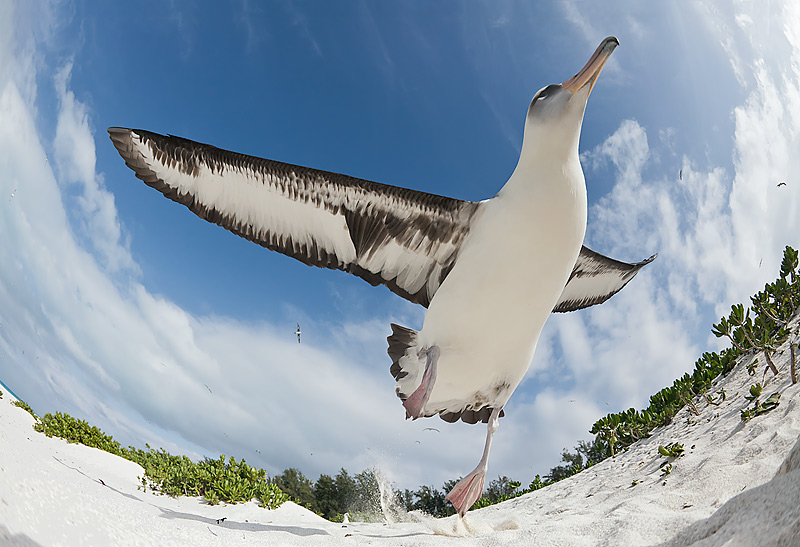
Laysan Albatross taking flight, close-focus, wide-angle, Midway Atoll, USA . Canon 5D MK2, Canon 15mm fisheye lens, AV, 1/5,000th sec, f8 (-1/3), ISO 1,250
This next image may just be my all time favorite image that I have taken. It’s exactly the kind of different image I want to take; one where the viewer has to think for a moment in terms of what he or she is actually looking at. In case you’re still wondering, I had positioned the camera and lens so that the lens was pointing directly up at the sky. The image shows an Albatross about to step on the lens. The white sand acts as a giant reflector helping to illuminate the bottom of the foot while the sun from above helps to bring out the translucent qualities of the foot and the veins inside it. I’m presenting a full frame image here, but it could probably be improved by cropping out the sunlit portion in the upper right
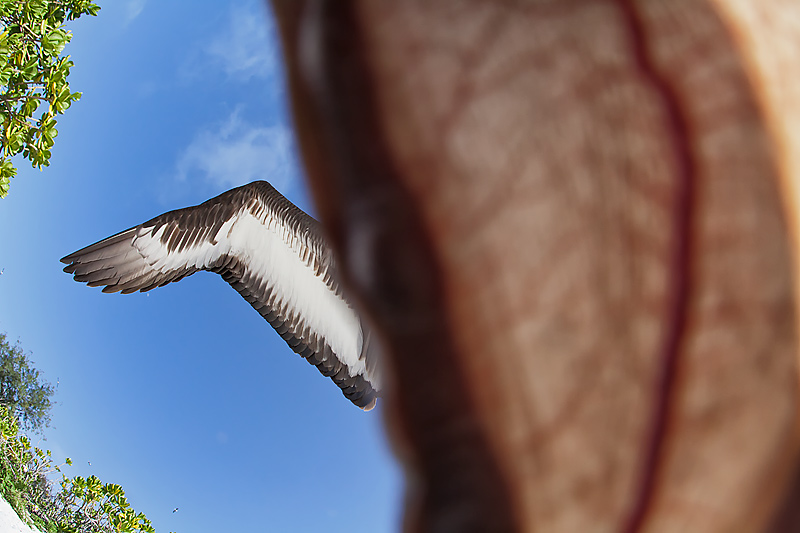
Laysan Albatross, close-focus, wide-angle, showing transluscent webbed foot, Midway Atoll, USA. Canon 5D MK2, Canon 15mm fish-eye lens, AV, 1/3,200 sec, f8 (-2/3), ISO 1,250
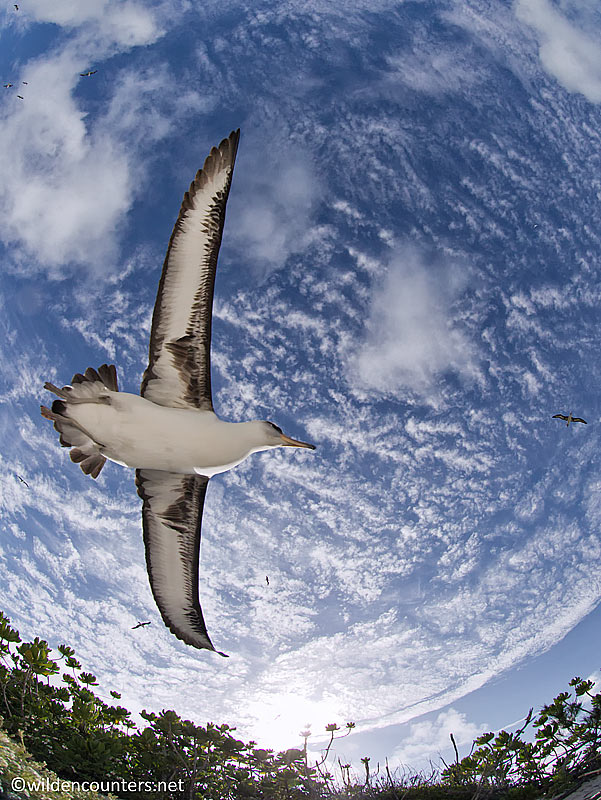
Laysan Albatross just after taking flight, close-focus, fish-eye, Midway Atoll, USA. Canon 1D MK4, Canon 8-15mm @11mm, AV, 1/6,400 sec, f8, ISO 1,250
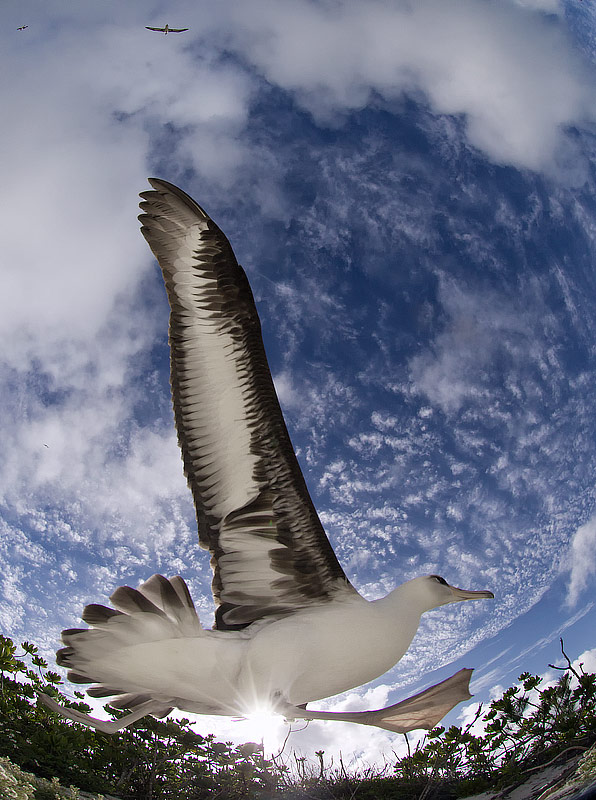
Laysan Albatross running to take flight, close-focus, fish-eye, Midway Atoll, USA. Canon 1D MK4, Canon 8-15mm lens @ 11mm, AV, 1/8,000th sec, f8, ISO 1,250
No trip to Midway is complete without spending time photographing the courting Red-Tailed Tropicbirds. 5,000 pairs of these birds nest on the ground of Midway between February and August, typically at the base of vegetation. The birds have extremely small legs, and feet set so far back on their bodies that they can barely walk. Walking in fact is an exaggeration for their movements on the ground are much closer to crawling. However, once in the air, it is a different story. In the middle of the day especially when the sun is out, large numbers can be seen above Midway’s beaches performing their acrobatic courtship flights. The birds circle, hover and even fly backwards, sometimes in unison with other birds, the sun shining through their brilliant white feathers and their long red tail streamers switching back and forth.
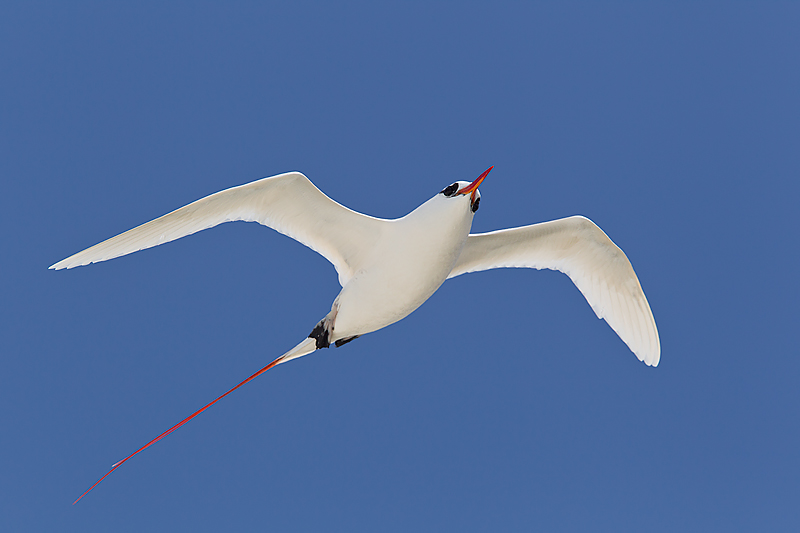
Red-Tailed Tropicbird in flight, Midway Atoll, USA. Canon 1DMK4, Canon 300mm f2.8 lens +1.4x TC, manual exposure, 1/2,000 th sec, f8, ISO 400
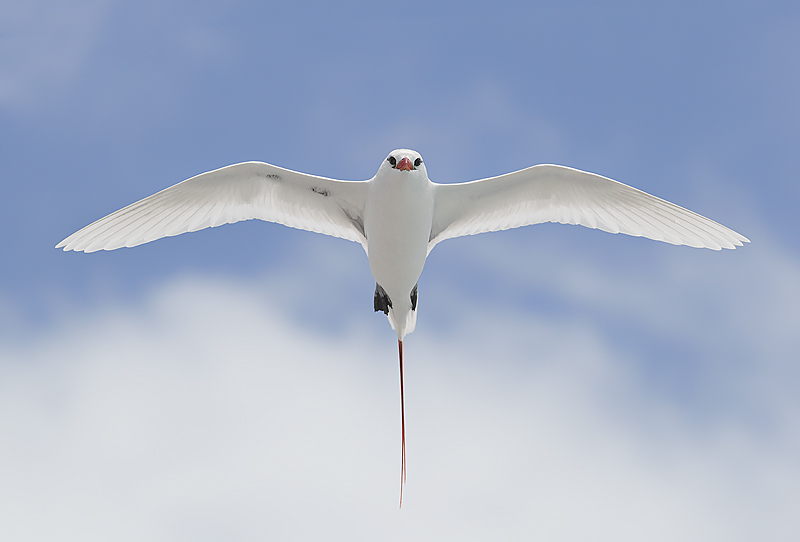
Red-Tailed Tropic bird hovering during courtship flight, Midway Atoll, USA. Canon 1DMK4, Canon 300mm f2.8 lens, handheld, manual, 1/1,250 sec, f7.1, ISO 400
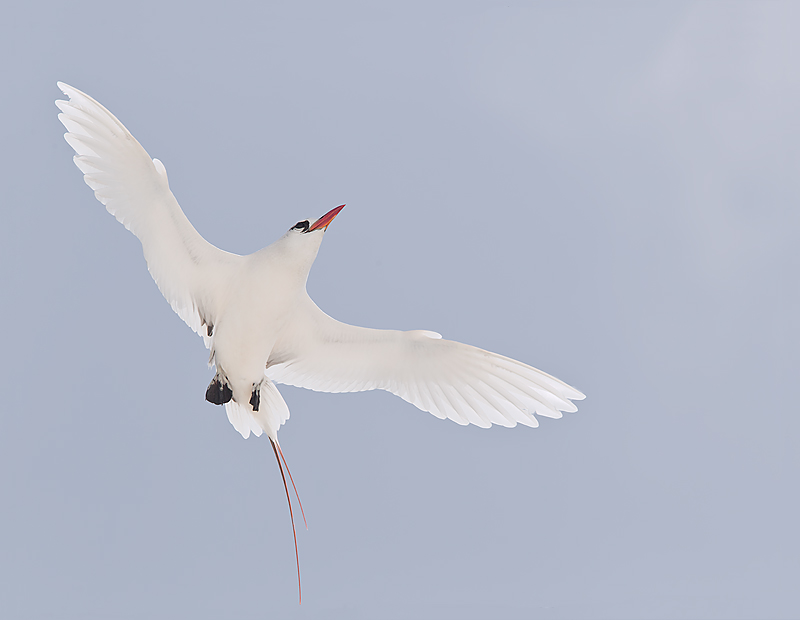
Red-Tailed Tropicbird hovering during courtship display, Midway Atoll, USA. Canon 1DMK4, Canon 300mm f2.8 lens + 1.4x TC, handheld, manual exposure, 1/1,250 sec, f8, ISO 400
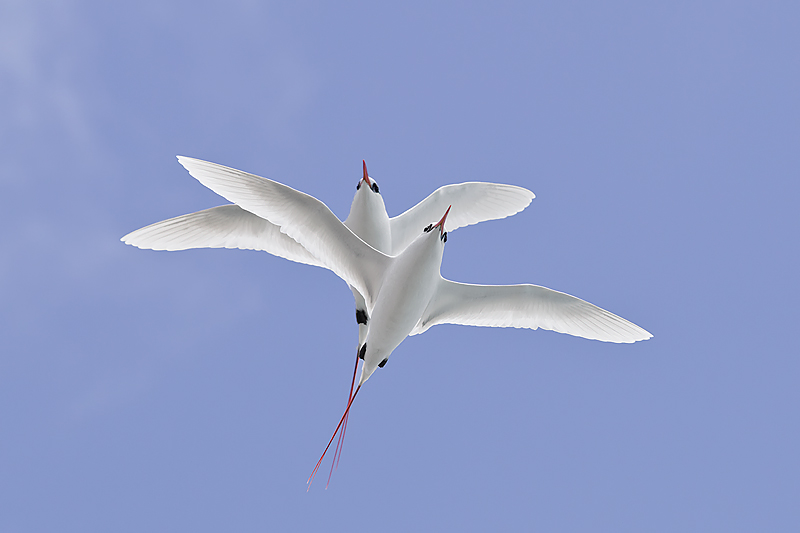
Red-Tailed Tropicbird pair performing courtship flight, Midway Atoll, USA. Canon 1DMK4, Canon 300mm f2.8 lens, handheld, manual exposure, 1/1,250 sec, f7.1, ISO 400
And so another Midway trip came to an all too soon end. Sadly, as I write, there now seems a very real chance that future visitor services maybe suspended due to budget constraints. Fingers crossed that this does not happen, but if it does, I will always treasure my times on this seabird Eden.
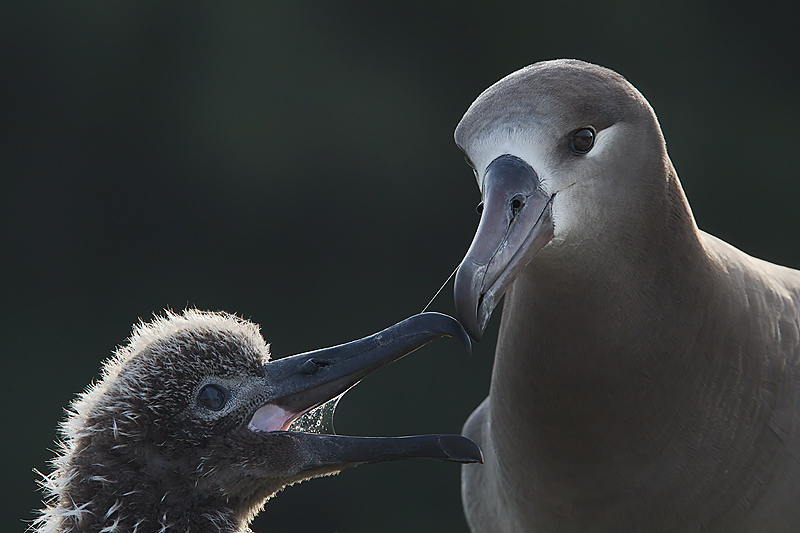
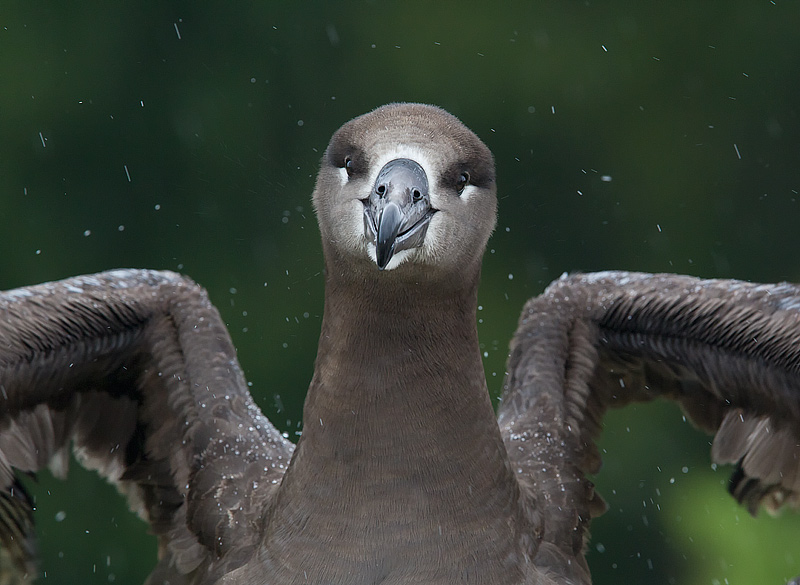
Isobel Wayrick
June 24, 2012
Paul….
Just would like to express my utmost respect for your talent and vision. I, too, love everything about Midway.
Isobel
Paul Mckenzie
June 26, 2012
Hi Isobel. Yes it’s an unbelievable place. Here’s hoping it stays open for visitors. Best regards, Paul
Anne Owen
June 25, 2012
Another outstanding set of photographs, Paul. The ones taken with the fish eye/remote triggers etc are stunning. Kindest regards.
Paul Mckenzie
June 26, 2012
Thanks Anne. Looks like Chile/Bolivia was good for your guys and that you had some water at the Solar. I was sorry to hear about your Dad. Take care. Paul
peter
June 25, 2012
Great pics, Paul. It was a pleasure to meet you at Midway.
Peter
Paul Mckenzie
June 26, 2012
Hi Peter. Was great meeting you too. Where have you ended up?
Alan Lillich
June 25, 2012
Wow. Jaw dropping. Thanks for the education and inspiration.
Paul Mckenzie
June 26, 2012
Really appreciate your generous priase Alan. Take care, Paul
Deborah Woodley
June 25, 2012
Paul,
Absolutely amazing.
Deborah
Paul Mckenzie
June 26, 2012
Thanks so much Deborah. Best regards, Paul
Gerhard & Sieglinde B.
June 25, 2012
Congratulations, Paul, to your marvelous and extraordinary shots.
Hearty greetings to you and all other participants of the recent Midway-tour.
We also hope that this was not the last occasion for a trip to “seabird Eden”.
Paul Mckenzie
June 26, 2012
Was great meeting you in Midway. Best regards, Paul
Mary Ann Longshore
June 25, 2012
I will never forget my time there in 2010. Thanks for taking me back again through your wonderful photoraphs.
Jaime Migoya
June 26, 2012
The remotely triggered images are stunning! You most have spent a lot of time spent in trial and error to get the correct exposure. Thank you for sharing them.
Clemens Vanderwerf
June 26, 2012
Very cool images Paul! You have certainly developed your on style in looking for different view points. Very inspirational. Look forward to see you in October.
Paul Mckenzie
June 26, 2012
Hi Clemens. I think you are more than equal when it comes to vision. Don’t think I would have had the vision to take that mesmerising image of yours that Arty posted on his blog recently (the bird leg in the surf) which definitely should win some awards. See you soon.
Ruth Vogele
June 26, 2012
Talent personified.
Thanks for sharing with me.
Ruth
Paul Mckenzie
June 26, 2012
Thanks Ruth for your support. Much appreciated. Paul
Julianne Piggotte
June 26, 2012
Thank you so much, Paul, for taking the time to explain some of your techniques. Your photographs are stunning in their artistry and a wonderful tribute to the birds and the atoll. I think that even if the budget cuts result in the closing we all fear, they should make a special exception for you to continue to document the Midway wildlife. No one else could possibly bring so much love to the project.
Paul Mckenzie
June 26, 2012
Wow! your comments really mean a lot to me. Take care. Paul
Richie Vernick
June 26, 2012
Paul,
Always an amazing artistic experience to look at your stuff. Make my pics of the same subjects mundane.
Paul Mckenzie
June 26, 2012
Hi Richie – thanks for your kind words (again!). Definitely hope that we can travel again. Paul
JAMES MENJO
June 26, 2012
Thanks for sharing. They are fascinating pictures.
Margie McNamara
June 26, 2012
I just love the candid up shots!! So much fun and action in them to grab your attention!
Margie McNamara
June 26, 2012
PS…where to next???????
Paul Mckenzie
June 27, 2012
French Polynesia for diving at a remote, secret location. Leaving tomorrow. Only a short trip but with a huge amount of travel much of it to be spent in the transit lounge at Auckland airport.
Robert Pickard
July 5, 2012
Another wonderful series of images – well done, Paul
Kathy Peavey
August 2, 2012
Outstanding images. These are the best photos I have ever viewed of the birds, wish I could see more.
Kathy Peavey b. Midway ’63 -left ’69, returned ’08 O.S. and ’09 to count the albatross. Your technique is fantastic. Thanks for sharing!
Paul Mckenzie
August 9, 2012
Hi Kathy, thank you for your kind words. It must have been very special to live on Midway when you did and then to see the changes when you returned.
Susan Christofides
August 5, 2012
Paul,
Great fish-eye images. I prefer seeing birds in their environment being more of a landscape enthusiast, although the portraits are very impelling.
Also, recognized a few participants from Antarctica who joined you on this trip.
Susan
PS: I thought you were a Nikon user – have you now gone over to the dark side?
Paul Mckenzie
August 9, 2012
Hi Susan, thx for stopping by and for your generous praise. Don’t think there were any Antarctica participants on the trip (some of the commentators yes). Heading back to South Georgia in about 2 months!
Byron Washom
August 6, 2012
Paul, You have done an excellent job of capturing the beauty of the Black Footed Albatross who mate for life and return to the exact spot to nest each year. Mahalo for your artistry.
Paul Mckenzie
August 9, 2012
Hi Byron, I think I like the Black-Foots even more than the Laysans, who are none too shabby themselves.
Roni
September 15, 2012
Incredible images! I am enjoying your blog. 🙂
Selena
February 20, 2013
Hi P fantastic descriptive images I am so very impressed well done you best wishes Selena x
Charles Condon
July 27, 2017
A wonderful experience back in time. I enjoyed the birds in ’70 on a tour of duty in the Navy, working boats around the islands.
Would love to return.
Charles Condon